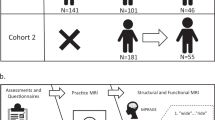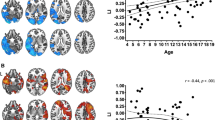Abstract
Half the members of the KE family suffer from a speech and language disorder caused by a mutation in the FOXP2 gene. We examined functional brain abnormalities associated with this mutation using two fMRI language experiments, one involving covert (silent) verb generation and the other overt (spoken) verb generation and word repetition. The unaffected family members showed a typical left-dominant distribution of activation involving Broca's area in the generation tasks and a more bilateral distribution in the repetition task, whereas the affected members showed a more posterior and more extensively bilateral pattern of activation in all tasks. Consistent with previously reported bilateral morphological abnormalities, the affected members showed significant underactivation relative to the unaffected members in Broca's area and its right homolog, as well as in other cortical language-related regions and in the putamen. Our findings suggest that the FOXP2 gene is critically involved in the development of the neural systems that mediate speech and language.
This is a preview of subscription content, access via your institution
Access options
Subscribe to this journal
Receive 12 print issues and online access
$209.00 per year
only $17.42 per issue
Buy this article
- Purchase on Springer Link
- Instant access to full article PDF
Prices may be subject to local taxes which are calculated during checkout




Similar content being viewed by others
References
Lai, C.S., Fisher, S.E., Hurst, J.A., Vargha-Khadem, F. & Monaco, A.P. A forkhead-domain gene is mutated in a severe speech and language disorder. Nature 413, 519–523 (2001).
Fisher, S.E., Vargha-Khadem, F., Watkins, K.E., Monaco, A.P. & Pembrey, M.E. Localisation of a gene implicated in severe speech and language disorder. Nat. Genet. 18, 168–170 (1998).
Vargha-Khadem, F., Watkins, K.E., Alcock, K.J., Fletcher, P. & Passingham, R.E. Praxic and non-verbal cognitive deficits in a large family with a genetically transmitted speech and language disorder. Proc. Natl. Acad. Sci. USA 92, 930–933 (1995).
Alcock, K.J., Passingham, R.E., Watkins, K.E. & Vargha-Khadem, F. Oral dyspraxia in inherited speech and language impairment and acquired dysphasia. Brain Lang. 75, 17–33 (2000).
Watkins, K.E., Dronkers, N.F. & Vargha-Khadem, F. Behavioural analysis of an inherited speech and language disorder: comparison with acquired aphasia. Brain 125, 452–464 (2002).
Hurst, J.A., Baraitser, M., Auger, E., Graham, F. & Norell, S. An extended family with a dominantly inherited speech disorder. Dev. Med. Child Neurol. 32, 352–355 (1990).
Watkins, K.E. et al. MRI analysis of an inherited speech and language disorder: structural brain abnormalities. Brain 125, 465–478 (2002).
Vargha-Khadem, F., Watters, G.V. & O'Gorman, A.M. Development of speech and language following bilateral frontal lesions. Brain Lang. 25, 167–183 (1985).
Salmond, C.H., Ashburner, J., Vargha-Khadem, F., Gadian, D.G. & Friston, K.J. Detecting bilateral abnormalities with voxel-based morphometry. Hum. Brain Mapp. 11, 223–232 (2000).
Belton, E., Salmond, C.H., Watkins, K.E., Vargha-Khadem, F. & Gadian, D.G. Bilateral brain abnormalities associated with dominantly inherited verbal and orofacial dyspraxia. Hum. Brain Mapp. 18, 194–200 (2003).
Vargha-Khadem, F. et al. Neural basis of an inherited speech and language disorder. Proc. Natl. Acad. Sci. USA 95, 12695–12700 (1998).
Friedman, L. et al. Brain activation during silent word generation evaluated with functional MRI. Brain Lang. 64, 231–256 (1998).
Herholz, K. et al. Individual functional anatomy of verb generation. Neuroimage 3, 185–194 (1996).
Paulesu, E., Frith, C.D. & Frackowiak, R.S.J. The neural correlates of the verbal component of verbal memory. Nature 362, 342–345 (1993).
Tomaiulo, F. et al. Morphology, morphometry and probability mapping of the pars opercularis of the inferior frontal gyrus: an in vivo MRI analysis. Eur. J. Neurosci. 11, 3033–3046 (1999).
Thierry, G., Boulanouar, K., Kherif, F., Ranjeva, J.P. & Demonet, J.F. Temporal sorting of neural components underlying phonological processing. Neuroreport 10, 2599–2603 (1999).
Thompson-Schill, S.L., D'Esposito,M. & Kan, I.P. Effects of repetition and competition on activity in left prefrontal cortex during word generation. Neuron 23, 513–522 (1999).
Liegeois, F. et al. A direct test for lateralization of language activation using fMRI: comparison with invasive assessments in children with epilepsy. Neuroimage 17, 1861–1867 (2002).
Thompson-Schill, S.L. et al. Verb generation in patients with focal frontal lesions: A neuropsychological test of neuroimaging findings. Proc. Natl. Acad. Sci. USA 95, 15855–15860 (1998).
Warburton, E. et al. Noun and verb retrieval by normal subjects. Studies with PET. Brain 119, 159–179 (1996).
Poldrack, R. et al. Functional specialization for semantic and phonological processing in the left inferior prefrontal cortex. Neuroimage 10, 15–35 (1999).
Price, C.J. The anatomy of language: contributions from functional neuroimaging. J. Anat. 197, 335–359 (2000).
Paulesu, E. et al. Functional heterogeneity of left inferior frontal cortex as revealed by fMRI. Neuroreport 8, 2011–2016 (1997).
Price, C.J. et al. Hearing and saying. The functional neuroanatomy of auditory word processing. Brain 119, 919–931 (1996).
Pickett, E.R., Kuniholm, E., Protopapas, A., Friedman, J. & Lieberman, P. Selective speech motor, syntax and cognitive deficits associated with bilateral damage to the putamen and the head of the caudate nucleus: a case study. Neuropsychologia 36, 173–188 (1998).
Martin, A. & Chao, L.L. Semantic memory and the brain: structure and processes. Curr. Opin. Neurobiol. 11, 194–201 (2001).
Dronkers, N.F. A new brain region for coordinating speech articulation. Nature 384, 159–161 (1996).
Ullman, M.T. A neurocognitive perspective on language: the declarative/procedural model. Nat. Rev. Neurosci. 2, 717–726 (2001).
Jueptner, M. & Weiller, C. A review of differences between basal ganglia and cerebellar control of movements as revealed by functional imaging studies. Brain 121, 1437–1449 (1998).
Alexander, G.E. Basal ganglia-thalamocortical circuits: their role in control of movements. J. Clin. Neurophysiol. 11, 420–431 (1994).
Di Pellegrino, G., Fadiga, L., Fogassi, L., Gallese, V. & Rizzolatti, G. Understanding motor events: a neurophysiological study. Exp. Brain Res. 91, 176–180 (1992).
Rizzolatti, G. & Arbib, M.A. Language within our grasp. Trends Neurosci. 21, 188–194 (1998).
Arbib, M.A. The mirror system, imitation, and the evolution of language. in Imitation in Animals and Artifacts (eds. Nehaniv, C. & Dautenhahn, K.) 229–280 (MIT Press, Cambridge, Massachusetts, 2002).
Enard, W. et al. Molecular evolution of FOXP2, a gene involved in speech and language. Nature 418, 869–872 (2002).
Acknowledgements
The authors thank J. Ashburner and C. Salmond for statistical advice, J. Ho and H. Ducie for assistance with collection of the MRI data, and the members of the KE family for their participation. This work was supported by the Wellcome Trust. Research at the Institute of Child Health and Great Ormond Street Hospital for Children NHS Trust benefits from Research and Development Funding from the NHS Executive.
Author information
Authors and Affiliations
Corresponding author
Ethics declarations
Competing interests
The authors declare no competing financial interests.
Supplementary information
Rights and permissions
About this article
Cite this article
Liégeois, F., Baldeweg, T., Connelly, A. et al. Language fMRI abnormalities associated with FOXP2 gene mutation. Nat Neurosci 6, 1230–1237 (2003). https://doi.org/10.1038/nn1138
Received:
Accepted:
Published:
Issue Date:
DOI: https://doi.org/10.1038/nn1138
This article is cited by
-
Experiment-driven rationalism
Synthese (2024)
-
The importance of deep speech phenotyping for neurodevelopmental and genetic disorders: a conceptual review
Journal of Neurodevelopmental Disorders (2022)
-
The genetic determinants of language network dysconnectivity in drug-naïve early stage schizophrenia
npj Schizophrenia (2021)
-
Decreased density of cholinergic interneurons in striatal territories in Williams syndrome
Brain Structure and Function (2020)
-
Differential effects of Foxp2 disruption in distinct motor circuits
Molecular Psychiatry (2019)



